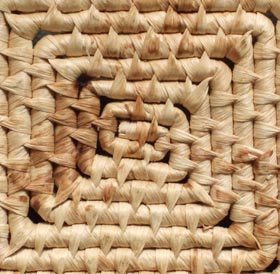Or search by topic
Number and algebra
Geometry and measure
Probability and statistics
Working mathematically
Advanced mathematics
For younger learners
Designing Table Mats




The photo on the right shows a table mat made from a coiled rope.
Chris wants to produce and sell sets of table mats like this. Her initial plan is to make them by coiling a thin rope into a rectangular pattern, sewing each layer to the next with 'thread' made of a strand of the material the rope is made from. Measuring a mat she already has, she decides that 30cm x 24 cm is a good size to aim for.
- Is this size possible using this method - coiling a length of rope as in this image?
- How might she rethink the design so she can make a bigger range of lengths and widths of mat?
You will need to make sensible assumptions about the thickness of the rope, and the construction of the mat including the length of the starting section of rope in the centre of the mat. Write down all the assumptions you make so you can revisit them and decide if they are acceptable.
You may also like
Rule of Three
If it takes four men one day to build a wall, how long does it take 60,000 men to build a similar wall?
Crossing the Atlantic
Every day at noon a boat leaves Le Havre for New York while another boat leaves New York for Le Havre. The ocean crossing takes seven days. How many boats will each boat cross during their journey?
Fixing the Odds
You have two bags, four red balls and four white balls. You must put all the balls in the bags although you are allowed to have one bag empty. How should you distribute the balls between the two bags so as to make the probability of choosing a red ball as small as possible and what will the probability be in that case?

